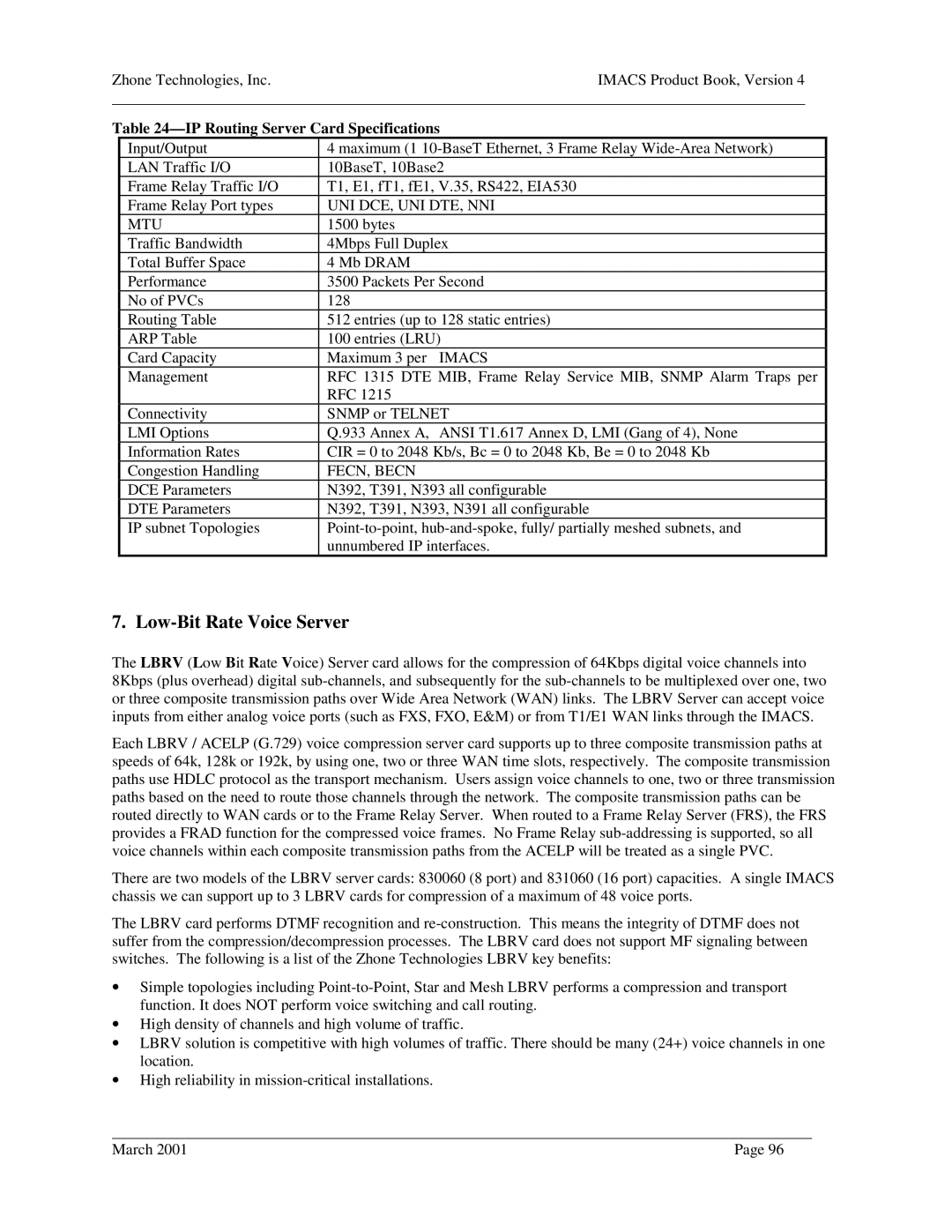Zhone Technologies, Inc. | IMACS Product Book, Version 4 | ||
|
|
|
|
Table | |||
| Input/Output | 4 maximum (1 | |
| LAN Traffic I/O | 10BaseT, 10Base2 | |
| Frame Relay Traffic I/O | T1, E1, fT1, fE1, V.35, RS422, EIA530 | |
| Frame Relay Port types | UNI DCE, UNI DTE, NNI | |
| MTU | 1500 bytes | |
| Traffic Bandwidth | 4Mbps Full Duplex | |
| Total Buffer Space | 4 Mb DRAM | |
| Performance | 3500 Packets Per Second | |
| No of PVCs | 128 |
|
| Routing Table | 512 entries (up to 128 static entries) | |
| ARP Table | 100 entries (LRU) | |
| Card Capacity | Maximum 3 per IMACS | |
| Management | RFC 1315 DTE MIB, Frame Relay Service MIB, SNMP Alarm Traps per | |
|
| RFC 1215 | |
| Connectivity | SNMP or TELNET | |
| LMI Options | Q.933 Annex A, ANSI T1.617 Annex D, LMI (Gang of 4), None | |
| Information Rates | CIR = 0 to 2048 Kb/s, Bc = 0 to 2048 Kb, Be = 0 to 2048 Kb | |
| Congestion Handling | FECN, BECN | |
| DCE Parameters | N392, T391, N393 all configurable | |
| DTE Parameters | N392, T391, N393, N391 all configurable | |
| IP subnet Topologies | ||
|
| unnumbered IP interfaces. | |
7.
The LBRV (Low Bit Rate Voice) Server card allows for the compression of 64Kbps digital voice channels into 8Kbps (plus overhead) digital
Each LBRV / ACELP (G.729) voice compression server card supports up to three composite transmission paths at speeds of 64k, 128k or 192k, by using one, two or three WAN time slots, respectively. The composite transmission paths use HDLC protocol as the transport mechanism. Users assign voice channels to one, two or three transmission paths based on the need to route those channels through the network. The composite transmission paths can be routed directly to WAN cards or to the Frame Relay Server. When routed to a Frame Relay Server (FRS), the FRS provides a FRAD function for the compressed voice frames. No Frame Relay
There are two models of the LBRV server cards: 830060 (8 port) and 831060 (16 port) capacities. A single IMACS chassis we can support up to 3 LBRV cards for compression of a maximum of 48 voice ports.
The LBRV card performs DTMF recognition and
•Simple topologies including
•High density of channels and high volume of traffic.
•LBRV solution is competitive with high volumes of traffic. There should be many (24+) voice channels in one location.
•High reliability in
March 2001 | Page 96 |
